Physical Address
304 North Cardinal St.
Dorchester Center, MA 02124
Patients with thyroid disorders most often present to the surgeon with a neck lump , which may be asymptomatic or it may cause symptoms or cosmetic deformity. A thyroid enlargement is generically known as a goitre , from the Latin for throat guttur , and increasingly, patients are being referred with nodule(s) detected by ultrasound, whilst investigating unrelated neck symptoms. Enlargement may be a discrete lump or an enlargement of the whole gland; in any case, the priority is to exclude malignancy. Most patients are clinically and biochemically euthyroid (i.e., have normal hormone levels). Some may be hyperthyroid (thyrotoxic) and are referred for surgery because medical treatment has failed and radioisotope treatment is unsuitable.
Patients with parathyroid disease may present with symptomatic hypercalcaemia or asymptomatic biochemically detected hypercalcaemia caused by excess parathormone ( hyperparathyroidism ). The cause may be a solitary adenoma, multigland hyperplasia or rarely, carcinoma. Primary hyperparathyroidism (pHPT) can be cured only by surgery.
Adrenal disease may present as an asymptomatic adrenal mass found during cross-sectional imaging; such ‘incidentalomas’ are found in around 4% of adult computed tomography (CT) scans. Symptomatic adrenal masses manifest with clinical features of hormonal excess, which vary with the cell of origin of the tumour.
Pathophysiological and clinical features of the various disorders are summarised in Table 49.1 , except for thyroid malignancy, outlined later in Table 49.3 .
| Disease | Pathophysiology | Clinical Features and Treatment |
|---|---|---|
| Inflammatory and Autoimmune Disorders | ||
| Autoimmune thyroiditis (AIT) or Hashimoto thyroiditis (common) | Diffuse lymphocytic infiltration. Over a period of years, follicles progressively destroyed producing atrophy and fibrosis. Antithyroid autoantibodies may be elevated (e.g., anti-TPO/anti-TG). Associated with other autoimmune disorders for example, pernicious anaemia/gastritis | Presents in adulthood with mild/moderate diffuse goitre or no goitre. Thyroid may be tender initially thyrotoxic/euthyroid phase followed by hypothyroidism. Females>>males NB thyroid lymphoma develops almost exclusively on background of autoimmune thyroiditis Treatment Reassurance. Thyroxine supplements for overt hypothyroidism |
| Autoimmune diffuse toxic goitre or Graves disease (fairly common) | Stimulation of thyrocytes by thyroid receptor antibodies (TRAbs) causing hyperthyroidism | Main presenting features are of thyrotoxicosis ± eye disease Diffuse goitre of variable size ± thyroid bruit. Infiltration of periorbital tissues causing Graves eye disease Treatment Antithyroid drugs Radioiodine ablation Surgery (total thyroidectomy) ± treatment of eye disease |
| Acute inflammatory thyroiditis or de Quervain thyroiditis (uncommon) | Granulomatous thyroiditis with probable viral aetiology | Prodromal viral illness is common. Exquisitely tender thyroid with moderate goitre. May be thyrotoxic in initial phase. Lasts weeks to months. May recur Treatment Self-limiting; supportive management with NSAIDs or aspirin Steroids occasionally given for prolonged local symptoms |
| Fibrotic thyroiditis or Riedel woody goitre (rare) | Dense fibrosis of the thyroid gland ± surrounding tissues. Aetiology uncertain but possibly autoimmune | Extremely hard, ‘woody’ thyroid. May cause compressive symptoms. May occur in conjunction with other fibrotic conditions, for example, retroperitoneal fibrosis or sclerosing cholangitis Treatment Distinguish from malignancy for example, anaplastic cancer by core or open biopsy Surgical resection of isthmus if airway compromise |
| Acute suppurative thyroiditis | Bacterial or fungal infection | Tender thyroid with systemic illness Treatment FNA to confirm diagnosis Antibiotics/antifungals |
| Postpartum thyroiditis | Possible autoimmune aetiology | Initial thyrotoxic phase followed by hypothyroid phase which persists long term in ∼25% Treatment Beta-blockade in thyrotoxic phase. Thyroxine may be required for hypothyroidism |
| Hyperplastic and Metabolic Disorders | ||
|---|---|---|
| Simple nontoxic colloid goitre (very common) | Benign, diffuse or multinodular hyperplasia of thyroid follicles. Cause is unknown but possibly minor abnormality of thyroid hormone synthesis | Diffuse or sporadic multinodular thyroid enlargement or single ‘adenomatous’ nodule or cyst. Patient clinically euthyroid and all thyroid function tests normal. Affects females much more than males |
| Endemic goitre (very rare in United Kingdom) | Diffuse hyperplasia of thyroid follicles because of dietary iodine deficiency or goitrogenic foods. Endemic in inland, developing countries, especially in mountainous areas | Diffuse, often massive thyroid enlargement, which may later become nodular. T4 is low or normal and TSH tends to be elevated |
| Drug-induced goitre (uncommon) | Diffuse thyroid hyperplasia secondary to interference with thyroid hormone synthesis. Drugs causing this are antithyroid drugs used in therapy (e.g., carbimazole) or others like lithium and aminoglutethimide | Diffuse thyroid enlargement. Patient usually euthyroid. Can be prevented by using replacement dose of T4 concurrently with blocking drugs (‘block and replace’) |
| Dyshormonogenesis (very uncommon) | Diffuse thyroid hyperplasia caused by a variety of uncommon genetic (recessive) defects affecting thyroid hormone synthesis | Presents at birth or in childhood with thyroid enlargement and severe hypothyroidism (cretinism). In developed countries, these defects are usually diagnosed at birth by neonatal screening tests before any goitre has developed |
| Physiological (common) | Diffuse thyroid hyperplasia often associated with pregnancy and puberty | Mild diffuse thyroid enlargement. Patient euthyroid |
| Type of Goitre | Example |
|---|---|
| Simple euthyroid goitre (sporadic/endemic) | Diffuse goitre |
| Multinodular goitre | |
| Toxic goitre | Diffuse autoimmune (Graves) |
| Toxic multinodular (Plummer) | |
| Solitary toxic nodule | |
| Thyroiditis | Autoimmune (Hashimoto) Subacute (de Quervain) |
| Fibrotic (Riedel) | |
| Neoplasia | Adenoma |
| Carcinoma (primary/metastasis) | |
| Other | Amyloidosis |
| Chronic bacterial infection (tuberculosis/syphilis) | |
| Actinomycosis |
| Condition (Relative Frequency in Developed Countries) | Pathophysiology | Clinical Features and Treatment |
|---|---|---|
| Papillary thyroid cancer (PTC) (relatively common—85% of thyroid malignancies, more in children) | Pathogenesis—activation of the RET protooncogene (rearranged during transfection) in 20% to 70% Forms complex branching structure with a fibrous stroma (papillary pattern) and psammoma (sand grain) bodies. Variable degree of dysplasia. Tends to be multifocal and locally invasive Commonly metastasises to cervical nodes even with small tumours, but distant metastases rare |
All age groups affected but more common in young/ middle-aged women Prognosis may be predicted using classifications, such as ‘AMES’ (age, metastases, extent, completeness of surgery). With appropriate treatment, only 10% die of their disease Surgery: hemi or total thyroidectomy and lymphadenectomy for known nodal spread or prophylactically in high-risk tumours Radioiodine therapy for all high-risk patients plus TSH suppression with high-dose thyroxine |
| Follicular thyroid cancer (relatively uncommon—10% of thyroid malignancies) | Tumour forms a well-developed follicular pattern reminiscent of normal thyroid. In general, well differentiated but metastasis is usually distant, for example, lungs and bone | Older age group affected Diagnosis: FNAC only identifies follicular nature but histology (possibly diagnostic hemithyroidectomy) needed to determine benign or malignant Prognosis less favourable than PTC, mainly because older age-group affected Surgery: extent depends on tumour characteristics with lymphadenectomy only if evident nodal spread is demonstrated Radioiodine ablation, TSH suppression and follow-up as for papillary carcinoma Inoperable differentiated cancer may be treated with targeted agents (e.g., the tyrosine kinase inhibitor Sorafenib) |
| Hürthle cell carcinoma (uncommon) | Prognosis: similar to an aggressive papillary carcinoma | Surgery: total thyroidectomy and central compartment lymphadenectomy |
| Anaplastic carcinoma (uncommon) | Dedifferentiated, aggressive variant of papillary or follicular carcinoma, rapidly spreading beyond confines of gland | Affects patients older than 60 years. Presents with a rapid appearance of a goitre Diagnosis: likely to require core biopsy Prognosis: very poor: survival >3 months is unusual Treatment: combination therapy with surgery, external beam radiotherapy and chemotherapy may help |
| Medullary thyroid cancer (very uncommon) | Aetiology: sporadic or part of MEN2 syndrome. Spreads via lymphatics | Surgery is the mainstay of treatment, as radioiodine not taken up Prognosis: intermediate between differentiated and anaplastic cancers |
| Lymphoma (uncommon) | Almost always a history of autoimmune thyroiditis | Chemoradiotherapy can be curative in localised disease |
| Thyroid metastases from elsewhere (rare) | Renal, breast, uterine or melanoma | Surgery: thyroidectomy may be appropriate Liaison with the team looking after the primary |
Most large thyroid swellings in developed countries are sporadic colloid goitres , that is, multinodular or diffuse hyperplasia. Multinodular goitres (MNGs) are the more common. They grow slowly and may eventually develop dominant nodules with functional autonomy (i.e., toxic nodules in older people).
Iodine deficiency is the usual cause of endemic goitres, often found in isolated mountainous regions, such as Himalayan Nepal. These are preventable by adding iodine to the diet. These endemic goitres are usually soft and composed of hyperplastic nodules. They may be symmetrical and can be enormous ( Fig. 49.1 ). Although unsightly, endemic goitres cause surprisingly few symptoms and the patient is usually euthyroid.
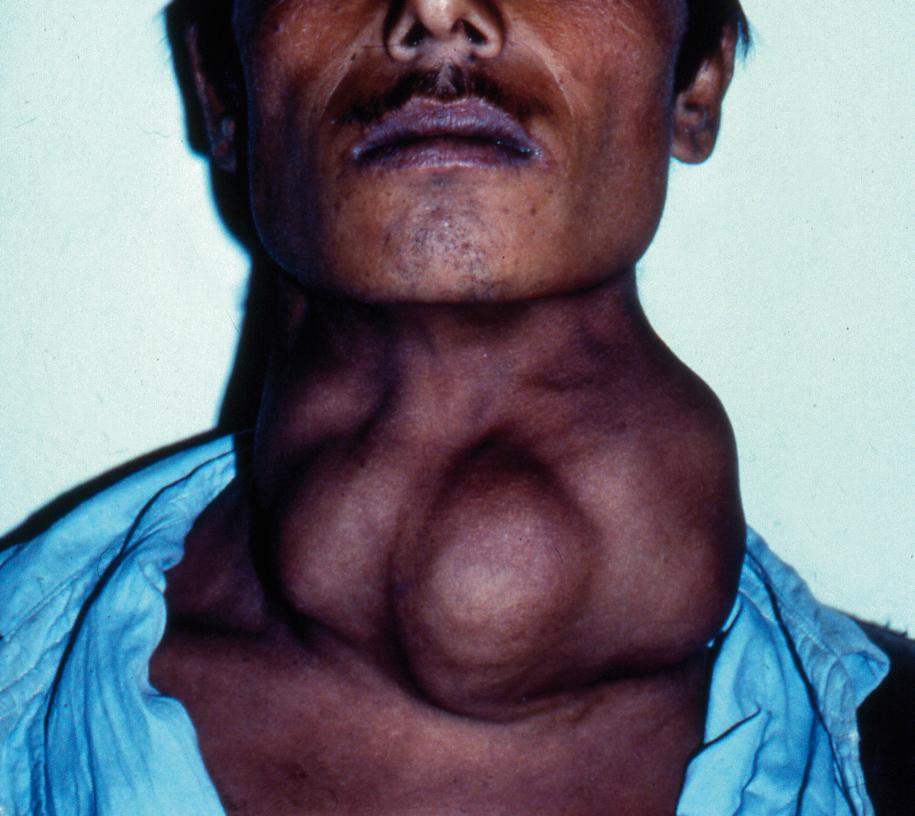
Anaplastic carcinoma causes hard fixed thyroid swellings, usually in elderly patients. There are usually symptoms of invasion, such as hoarseness (recurrent laryngeal nerve invasion), and stridor caused by tracheal invasion ( Fig. 49.2 ). The uncommon thyroid lymphoma presents with diffuse enlargement and needs to be distinguished from anaplastic cancer.
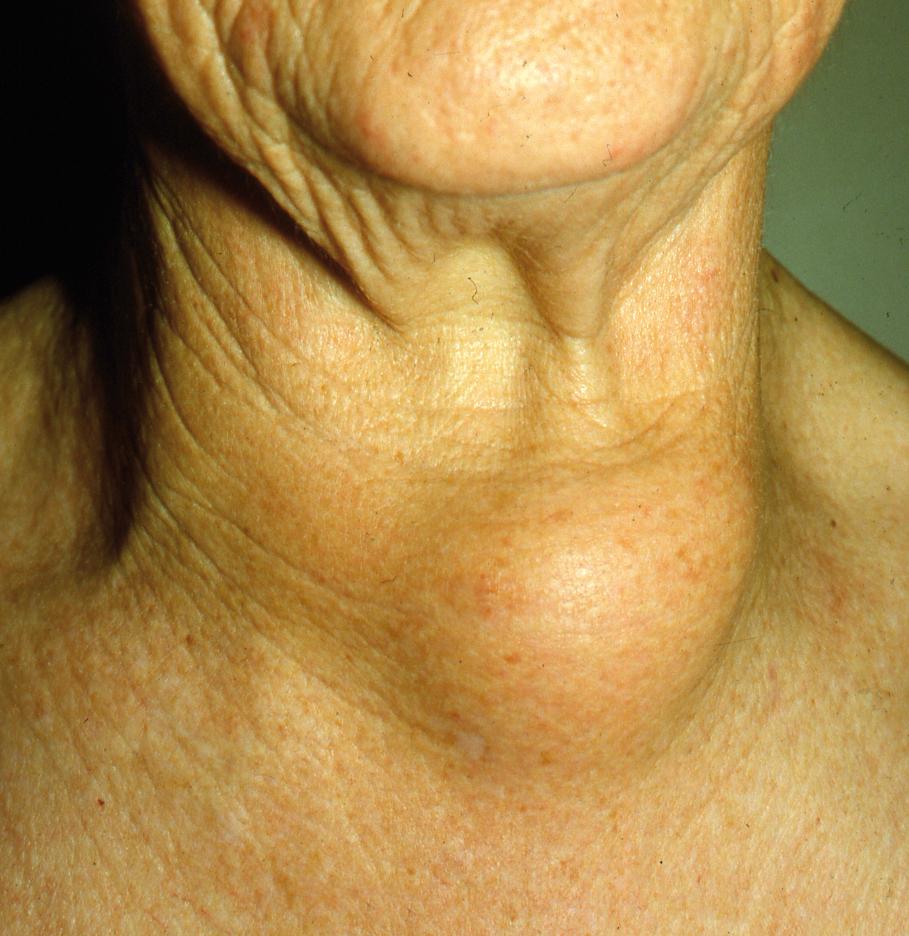
In Graves disease (GD, primary hyperthyroidism), there is usually smooth mild thyroid enlargement. In Hashimoto thyroiditis, the gland is moderately enlarged, firm and finely nodular.
Solitary thyroid nodules on clinical examination are common but half prove to be multinodular on imaging. The clinical appearances of MNG are shown in Fig. 49.3 . A solitary nodule is usually idiopathic hyperplasia and if discrete, is a thyroid adenoma . Thyroid cysts are fairly common and adenomas and cysts both fall within the description simple or multinodular colloid goitre .
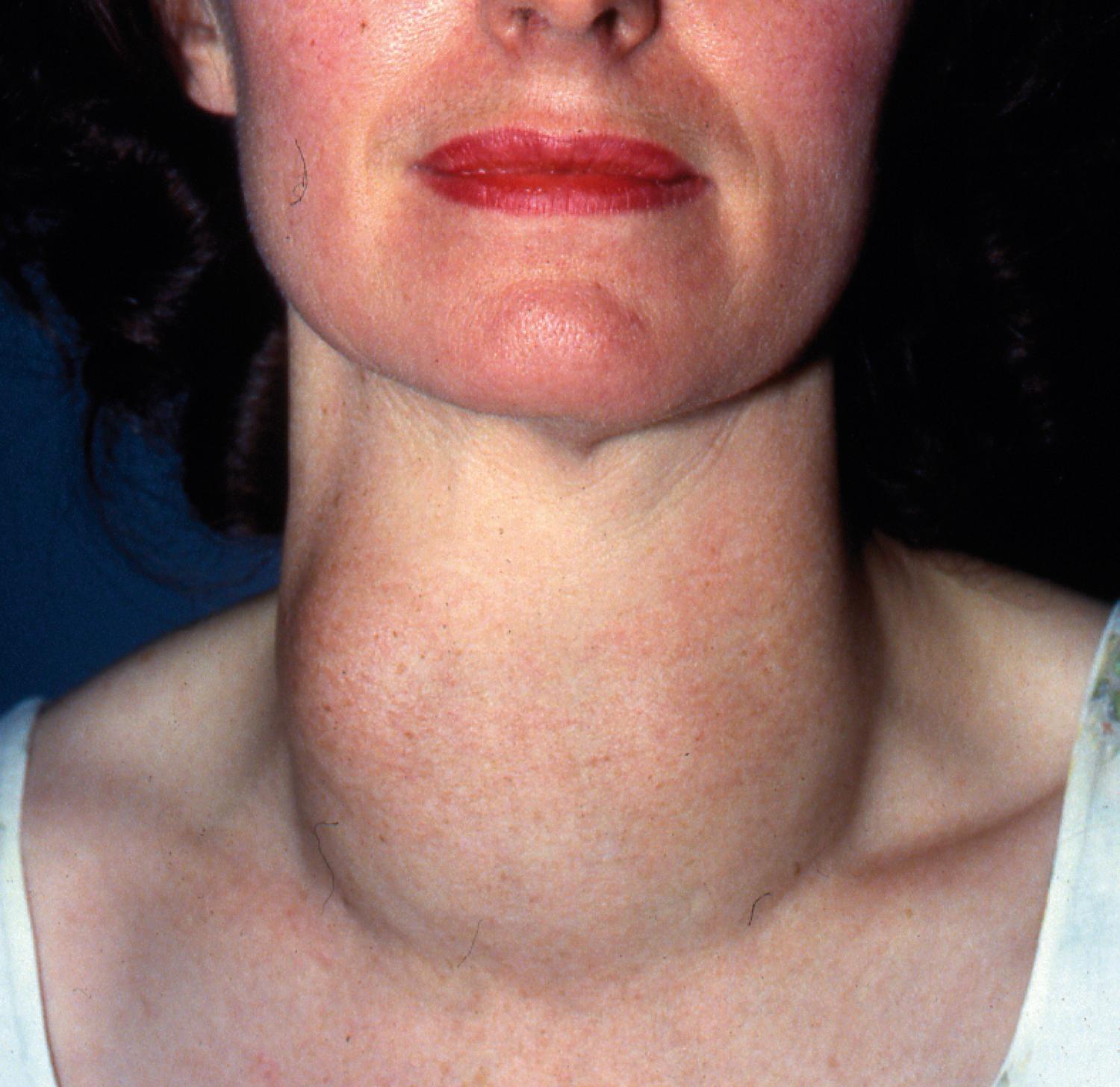
Small nodules are found incidentally—noticed when the patient swallows, or on ultrasonography. Only 5% of true solitary nodules are malignant but this rises substantially in patients with a history of neck irradiation. Fallout from the Chernobyl nuclear meltdown caused many thyroid cancers in children exposed under the age of 14 years. Thyroid cancer risk is higher in nodules at the extremes of age, more particular in childhood. Malignancy needs to be excluded in any solitary nodule, with fine-needle aspiration cytology (FNAC) as the investigation of choice.
A new area of enlargement in an existing goitre may result from haemorrhage into a cyst or nodule (this appears rapidly), growth of a hyperplastic nodule or a developing carcinoma. If enlargement extends into the anterior mediastinum behind the sternum (see Fig. 49.6 ), this retrosternal goitre may compress or displace the trachea, causing stridor , often obvious only with the neck in certain positions, such as sleeping on one side. Hoarseness or stridor may also result from malignant invasion of the recurrent laryngeal nerve or trachea. Vocal cord palsy causes dysphonia (speech abnormalities) and should prompt vocal cord examination with fibreoptic nasendoscopy in the clinic.
Pain and tenderness are uncommon presenting features but characterise the rare infective de Quervain thyroiditis . Sometimes the thyroid is painful and tender in Hashimoto thyroiditis.
Thyrotoxicosis is the term for the clinical syndrome of hypermetabolism resulting from an excess of thyroid hormones, thyroxine (T4) ± triiodothyronine (T3). The clinical manifestations are summarised in Box 49.1 (also Fig. 49.4 ). Mild hyperthyroidism may occur in the early stages of Hashimoto thyroiditis, burning out later with the patient becoming hypothyroid. A solitary adenomatous nodule may produce excess hormone causing hyperthyroidism and is known as a toxic or hot nodule .
Metabolic —heat intolerance, increased appetite with weight loss, diarrhoea, menorrhagia
Cardiovascular —palpitations, tachycardia even while asleep, atrial fibrillation
Neuropsychiatric —hyperkinesis, insomnia, emotional instability, tremor, proximal myopathy
Ocular —exophthalmos including proptosis, lid retraction and eventually ophthalmoplegia
Cutaneous —pretibial myxoedema
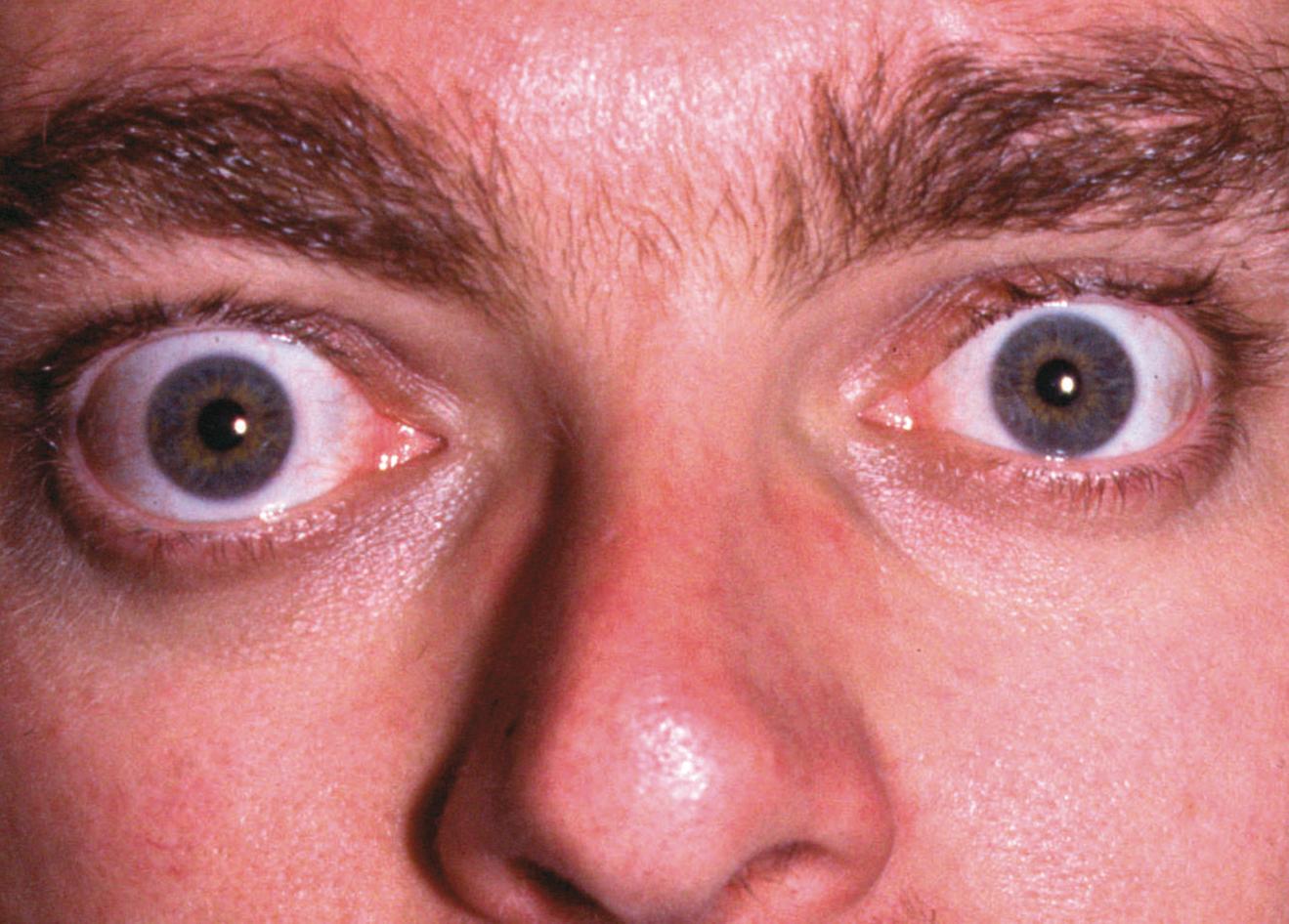
Hypothyroidism is a deficiency of thyroid hormones resulting from inadequate synthesis and is usually because of autoimmune thyroiditis, primary gland atrophy or following treatment for thyrotoxicosis. Hypothyroidism is a complication in up to 25% of cases after subtotal thyroidectomy (now less commonly performed), after radioiodine therapy for thyrotoxicosis, and is inevitable after total thyroidectomy. Hypothyroidism is more common in women of advancing age and should be considered in surgical patients presenting with constipation. It has also been implicated in spontaneous aortic thrombosis in middle-aged women.
The patient should be seated in a chair with space to palpate from behind and have a glass of water available to swallow ( Fig. 49.5 ). General examination should look for signs of hyperthyroidism (as listed in Box 49.1 ) and for specific signs of Graves eye disease (see Fig. 49.4 ) (exophthalmos and ophthalmoplegia). Next, the front of the neck is inspected, while the patient swallows; the characteristic rise of a thyroid swelling results from its investment in pretracheal fascia attached to the larynx above. A normal thyroid is not visible even on swallowing and is not normally palpable.

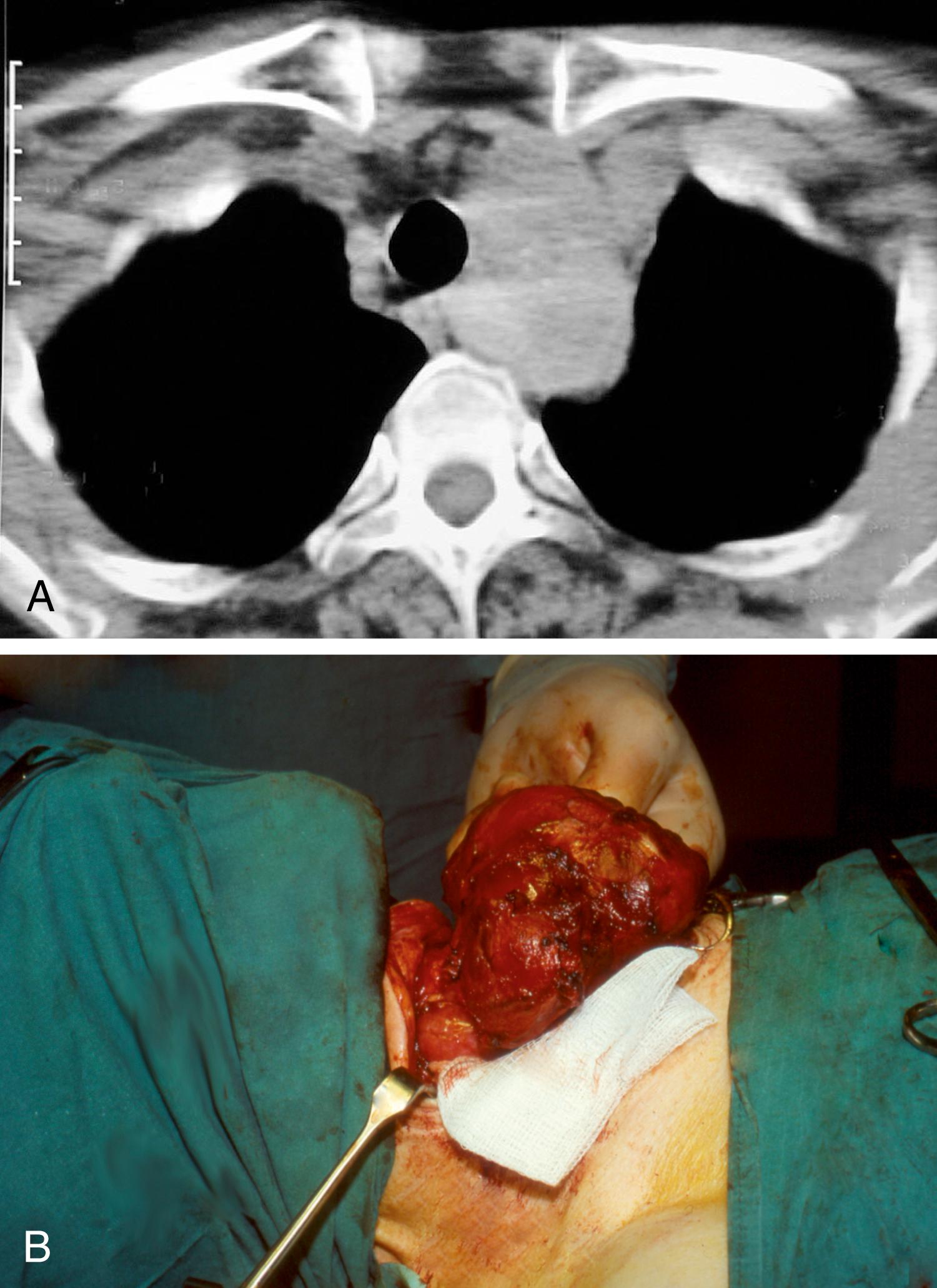
The thyroid area is next palpated from behind. This is best for examining the size, shape and consistency of the gland. It also allows the lower edge of a swelling to be palpated to identify retrosternal extension. The thyroid lobes wrap around the larynx and lie deep to the strap and sternomastoid muscles, which tend to conceal thyroid enlargement and make it tricky to examine the whole gland. Thyroid tenderness may indicate thyroiditis; a diffuse and smoothly enlarged gland suggests a benign process, such as endemic, multinodular or physiological goitre. A clinically solitary or dominant nodule or firmness, irregularity of margins, fixity and/or dysphonia may indicate malignancy. Most retrosternal goitres arise in continuity with a large component in the neck, whilst others may be predominantly substernal.
The jugular chain of lymph nodes should be palpated for metastases. In thyrotoxicosis, auscultation may reveal a bruit of increased vascularity.
If there is suspicion of recurrent laryngeal nerve palsy because of hoarseness , laryngoscopy should be performed, especially if surgery is contemplated.
The questions during investigation are summarised in Box 49.2 and described in detail later. Patients after neck radiotherapy should be considered at high risk of thyroid carcinoma.
General thyroid status —thyroid function tests and thyroid autoantibodies
Morphology of the gland , that is, size, shape and physical consistency, effects upon surrounding structures—ultrasound, plain x-rays of thoracic outlet, computed tomography scanning
Tissue diagnosis —fine needle aspiration cytology or needle biopsy, incision or excision biopsy
First establish whether the patient is euthyroid , hyperthyroid or hypothyroid . Initially, this is clinical but plasma thyroid stimulating hormone (TSH) level is low in hyperthyroidism and elevated in hypothyroidism. Most laboratories measure just the TSH level initially but estimations of free T4 (fT4) may follow. If the patient is clinically hyperthyroid, but the fT4 is normal, elevated T3 levels are likely and can be measured.
Thyroid autoantibodies are assayed if autoimmune disease or lymphoma is possible (lymphoma usually occurs on a background of Hashimoto thyroiditis). Hashimoto is characterised by elevated antithyroid peroxidase antibodies. If medullary thyroid carcinoma (MTC) is suspected, calcitonin level should be checked and if elevated, plasma or urinary metanephrines measured because MTC can be associated with phaeochromocytoma in multiple endocrine neoplasia type II syndrome (MEN 2).
Imaging is next performed to assess the morphology of the thyroid and to guide FNAC. It can also detect retrosternal extension. Core biopsy for histology is not required except in suspected lymphoma or anaplastic thyroid cancer. Ultrasound is recommended by the British Thyroid Association to classify thyroid nodules. Ultrasound features suggesting malignancy include hypoechoicity, microcalcification and irregular margins (all 80%–90% sensitive), nodules that are ‘taller than wide’ and those with central vascularity. Ultrasound also has excellent sensitivity and specificity in detecting cervical lymphadenopathy when staging thyroid malignancy, particularly in the lateral compartment, and can guide FNAC of nodes.
CT scanning of neck and thoracic outlet is used in:
apparent tracheal displacement or compression;
assessing the extent of retrosternal goitres;
detecting lymph node and distant metastases if malignancy is suspected.
The gold standard for investigating possible malignancy in solitary and dominant thyroid nodules is FNAC. Ultrasound guidance reduces the false negative and nondiagnostic rate compared to ‘freehand’ FNAC and in the United Kingdom, cytology is reported using the ‘Thy’ classification. If a colloid nodule is diagnosed, excision is needed only for compressive symptoms or less commonly for cosmetic deformity. Obviously malignant lesions usually require surgery. These include papillary , medullary and early anaplastic carcinomas . Most lymphomas are inadequately sampled by FNAC or core biopsy and may need open incision biopsy. Follicular carcinomas cannot be distinguished cytologically from benign follicular adenomas ; both display sheets of follicular cells, so lesions with this appearance should be removed, although only 20% will be malignant.
Radionuclide (iodide) imaging proved unreliable at predicting malignancy and its current role is in characterising the cause of thyrotoxicosis ( Fig. 49.7 ): GD shows even uptake across the gland, whereas toxic MNG shows patchy uptake. In solitary toxic adenoma (which is rarely malignant), the nodule is intensely avid, while the rest of the gland uptake is suppressed. Viral thyroiditis is characterised by no uptake and a blank film. Isotope scanning can also identify and localise ectopic thyroid tissue (in the tongue or along the course of the thyroglossal duct), retrosternal extension of a thyroid swelling and metastases of functioning thyroid carcinomas, provided the thyroid has previously been removed or ablated.
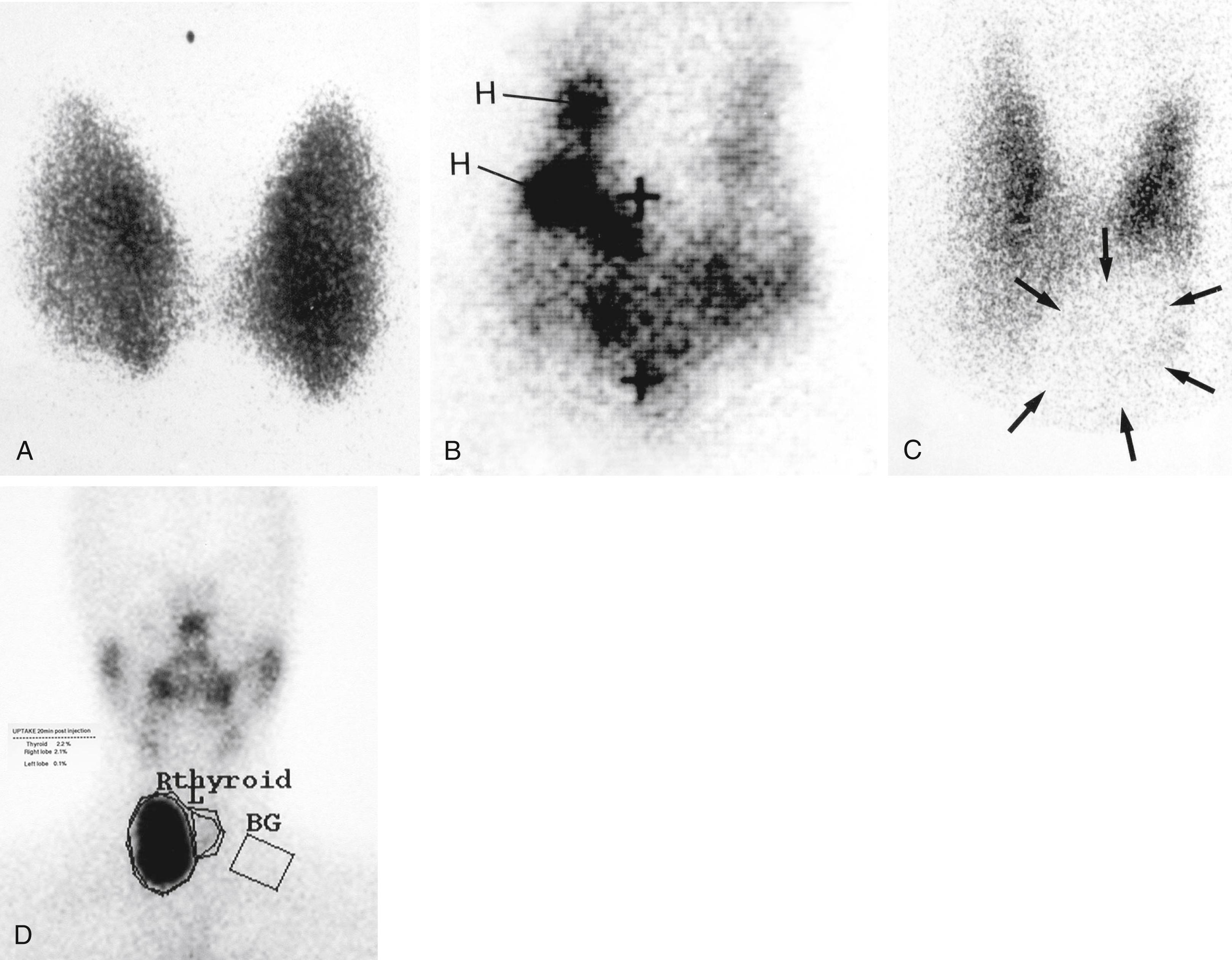
With benign multinodular goitre, surgery is only indicated to relieve compressive symptoms; large nodule size is not of itself an indication. Most retrosternal goitres can be removed via a broad neck incision though sternotomy is occasionally required.
Two percent of women and 0.2% of men in the United Kingdom have hyperthyroidism. Untreated, it causes weight loss, anxiety, tachycardia, palpitations and increased risk of cardiovascular-related death. Most are caused by Graves’ disease, some by toxic multinodular goitre and a few by toxic adenoma. Graves’ disease is an autoimmune condition in which antibodies stimulate TSH receptors, causing excess thyroid hormone synthesis; secretion becomes independent of pituitary feedback. Thyroid hypertrophy results in a mild diffuse goitre. Eye manifestations occur in up to 50% including proptosis, exophthalmos and a staring appearance, which arise from autoimmune involvement of periorbital muscle, fat and skin causing retroorbital oedema. These can produce symptoms of diplopia, pain, visual deterioration (because of optic nerve compression and stretching) and rarely, corneal scarring from extreme dryness. The diagnosis of Graves’ disease is usually suspected clinically and confirmed by thyroid autoantibody titres: thyroid receptor antibody (TRAb) is elevated in 80% to 90% of patients with Graves.
Hashimoto thyroiditis may produce transient hyperthyroidism. If in doubt, the aetiology of hyperthyroidism can be determined by radioisotope scanning. Carcinoma is very rarely found in hyperthyroid patients.
There are three options: antithyroid drugs, radioiodine destruction of functioning thyroid tissue and thyroidectomy. Antithyroid drugs are the first line in Europe except in the elderly and unfit, whereas radioiodine is preferred as an early treatment in the United States of America. Patients with arrhythmias, angina or osteoporosis are usually treated with radioiodine from the outset. Antithyroid drugs can cause hypothyroidism, which is avoidable by using a ‘block and replace’ regimen (concurrent antithyroid drug and T4). Carbimazole is favoured in the United Kingdom, with propylthiouracil used in pregnancy (as it crosses the placenta less readily) or as second line if carbimazole causes side effects. Beta-adrenergic blockers, such as propranolol , rapidly control the distressing and dangerous effects of thyrotoxicosis and are useful in extremely toxic patients, until antithyroid drugs take effect, or if a patient needs to be stabilised urgently before thyroidectomy. In those treated surgically, recurrence is rare after total thyroidectomy. All groups report 95% satisfaction, with no differences in quality of life between the groups.
Iodine-131 (I-131) ablation is safe and has been used for nearly 75 years with no evidence of later malignancy, as a relatively low radiation dose is used. Absolute contraindications are pregnancy and breast-feeding and active Graves eye disease. Up to 60% of patients develop hypothyroidism within a year of treatment and close monitoring of thyroid function tests is mandatory. Radioactive iodine is given by mouth as capsules or solution, in doses 100 times higher than for diagnostic scanning. Beta particle emission destroys the most active thyroid tissue over a period of weeks or months. Antithyroid drugs usually need to continue until radioiodine achieves its greatest effect. After treatment, gamma rays are emitted from the patient’s body and may be absorbed by others nearby, so relative isolation is necessary at first. Patients should avoid pregnancy for 6 months afterwards.
Many units now aim to make patients hypothyroid within 6 months and routinely provide levothyroxine replacement. Toxic multinodular disease and toxic adenoma also respond to radioiodine. Radioiodine may make thyrotoxic ophthalmopathy worse, whereas antithyroid drugs and surgery do not affect its course. Surgery is generally preferred in Graves patients with ophthalmopathy.
Surgery for thyrotoxicosis may be indicated:
When a quick and effective cure is desired that avoids long-term drug therapy. It is often the best treatment for Graves disease, particularly in younger patients in whom the disease is unlikely to burn itself out for years.
If there is poor control by antithyroid drugs or relapse after initial successful treatment.
In toxic MNG, where response to drug treatment is unpredictable; surgery also deals with the cosmetic deformity.
In toxic solitary nodules (‘hot nodules’), which are best excised to allow suppressed normal thyroid to recover.
In active Graves eye disease, or another contraindication to I-131, plus intolerance or poor compliance with antithyroid drugs.
If there are large goitres or possible malignant thyroid nodules.
Total thyroidectomy is the gold standard; subtotal thyroidectomy is now a historical operation, given the risk of recurrence. Proper preparation for surgery involves rendering the patient euthyroid, or at least achieving cardiovascular stability, using antithyroid drugs, beta-blockade and/or saturation of the gland with iodine. Lugol iodine or potassium iodide are effective, but surgery must be done within 14 days or rebound toxicity may occur. For all thyroid operations, preoperative assessment usually includes laryngoscopy , to demonstrate normal vocal cord function, should there be a question of operative damage later. There may be a more subtle change in voice quality after thyroidectomy, sometimes because of external laryngeal nerve damage. Patients should be warned of this, especially if they are singers or politicians!
At operation, a transverse collar incision along a skin crease gives the best cosmetic result. Meticulous care is required in ligating the terminal branches of the inferior thyroid artery (after identifying the recurrent laryngeal nerve) and the upper pole vessels . Primary or postoperative haemorrhage is a serious complication, causing laryngeal oedema and airway compromise. To avoid suffocation from a postoperative bleed, instruments for emergency reopening of the wound should be kept at the patient’s bedside after operation. The potential complications of thyroidectomy are summarised in Box 49.3 .
Haemorrhage—uncommon.
Recurrent laryngeal nerve injury—may result from traction or heat (and be potentially reversible) or from division (rare). Bilateral nerve damage presents as laryngeal obstruction after tracheal extubation and may necessitate tracheostomy. Unilateral damage causes hoarseness and a weak voice and impairs coughing.
Inadvertent damage to other structures—tracheal or oesophageal perforation or damage to laryngeal muscles or nerves.
Major haemorrhage—can be devastating if rapid, leading to venous congestion, laryngeal oedema and airway embarrassment. Risk highest in first 24 hours and in patients with Graves disease or after nodal dissection. Risk may be reduced by nursing patients in a semi-sitting position. The fear of haematoma is the main argument against day case thyroidectomy.
Early hypocalcaemia—transient postoperative hypocalcaemia (<2 mmol/L) because of compromise of the parathyroids is common: 25%–40%. Permanent hypoparathyroidism occurs in 1%–3%. Profound hypocalcaemia causes hyperexcitability with initial perioral and fingertip paraesthesia. May progress to tetanic contractures, seizures and death if untreated. Oral calcium ± activated vitamin D are sufficient in most cases if commenced early; IV calcium should be avoided. Serum calcium and PTH should be measured at least once in the 24 hours postoperative.
Mediastinal haemorrhage (rare)—presents with hypovolaemic shock.
Thyrotoxic crisis (rare but may occur after surgery in Graves disease)—presents with abrupt onset of extreme agitation and confusion, hyperpyrexia, profuse sweating and rapid tachycardia or other arrhythmia. Requires emergency beta-blockade, IV hydrocortisone and potassium iodide. The mortality of thyrotoxic crisis is 10%—from coma, pulmonary oedema or circulatory collapse. It is rare if the patient has been rendered euthyroid by drug treatment before operation.
Tracheomalacia (rare)—removal of a longstanding lesion compressing the trachea may lead to tracheal collapse and stridor.
Hypoparathyroidism—persistent hypocalcaemia because of inadvertent parathyroid damage. Presents with muscle cramps, paraesthesia and tetany within 36 hours of operation. Treatment is with calcium and vitamin D analogues.
Unilateral recurrent laryngeal nerve damage—presents with hoarse voice and defective cough.
External laryngeal nerve damage—changes the quality of the voice.
Hypothyroidism—often overlooked because it develops insidiously. Features are loss of energy, weight gain, depression and intellectual deterioration and intolerance of cold weather.
Recurrent thyrotoxicosis—insufficient gland removed. Rare in total thyroidectomy.
Thyroid cancer is the most common endocrine malignancy with 3500 new diagnoses a year in the United Kingdom. Nevertheless, overall thyroid malignancies represent less than 1% of all malignant tumours. Overall mortality from thyroid cancer is relatively low (380 deaths per annum in the United Kingdom) with 80% of patients expected to survive 10 years. However, thyroid cancer has a huge range of aggressiveness from indolent microscopic papillary cancers to wildfire anaplastic cancer in older patients, amongst the most aggressive cancers known.
Thyroid cancers are classified by cell type of origin as primary or secondary, and grouped according to level of differentiation. Cell types involved are thyrocytes (giving rise to papillary, follicular, Hürthle cell and anaplastic carcinomas), parafollicular C cells (medullary thyroid cancer) and lymphocytes (lymphoma). Metastatic spread occasionally occurs to the thyroid from renal, breast or uterine carcinoma or melanoma. Differentiated thyroid cancers (papillary and follicular) show typical features of their parent cell type, with low metastatic potential, and carry the best prognosis. Undifferentiated cancers have the worst prognosis and medullary cancer carries an intermediate prognosis.
In most thyroid cancers, no aetiological factor is identified, but known risk factors for primary thyroid malignancy are:
Age—malignancy rates in thyroid nodules are twice as high under 30 years or over 60 years compared with 30 to 60 years.
Gender—malignancy is three times as common in females, but a thyroid nodule in a man is twice as likely to be malignant.
Radiation exposure—evidence comes from survivors of nuclear bombs (Hiroshima and Nagasaki in 1945) and accidents (Chernobyl in 1986). The risk is highest if exposure occurs under 14 years and with concurrent iodine deficiency.
Inherited disorders—medullary cancer may arise in multiple endocrine neoplasia (MEN) 2. Papillary and follicular cancers also have familial variants.
Become a Clinical Tree membership for Full access and enjoy Unlimited articles
If you are a member. Log in here